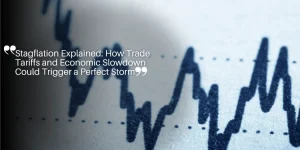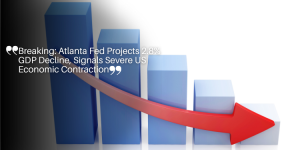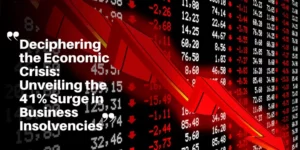What Causes Economic Recessions? Complete Guide to America’s Latest Downturn
Defining a Recession
A recession refers to a substantial decline in economic activity that lasts for more than a few months.
This period of economic downturn broadly affects various sectors including industrial production, employment, real income, and overall business profitability.
Traditional Indicators: Two Consecutive Quarters of GDP Decline
A common indicator of a recession is a decline in a country’s gross domestic product (GDP)—the total value of goods and services produced—for two consecutive quarters.
GDP is a comprehensive measure of a country’s overall economic activity. Decline in this figure suggests that the economy is not producing as much as it once did.
Broader Economic Indicators
However, relying solely on GDP to identify a recession can be misleading. Economists and policymakers look at a broader range of economic indicators to get a more detailed picture:
| 📉 Indicator | ⚠️ Warning Sign |
|---|---|
| 💼 Employment Rates | Large-scale job losses and declining employment indicate an economic downturn. |
| 🏭 Industrial Production | Declines in manufacturing, mining, and utilities suggest reduced economic output. |
| 🛍️ Consumer Spending | A slowdown in discretionary spending signals an impending or ongoing recession. |
| 🏢 Business Investment | Lower investment levels suggest companies are expecting economic struggles. |
| 🛒 Retail Sales | A drop in retail sales is a key sign of economic distress, impacting businesses first. |
Economic recessions can be complex and multi-causal events that require a comprehensive analysis of several interrelated economic activities.
While GDP is an important metric, understanding a recession involves a broader look into underlying economic indicators.
With these fundamental concepts in mind, we can further explore what drives these downturns and the factors that contribute to the cyclical nature of economic recessions.
Key Causes of Recessions
Recessions do not happen due to a single factor; rather, they manifest from a mixture of economic, financial, and psychological causes.
Understanding these causes is essential for grasping the dynamics behind economic downturns.
Economic Factors
Economic factors primarily involve changes within industries and the overall market landscape. Structural shifts, such as technological advancements or evolving consumer preferences, can disrupt established sectors.
A prime example is the rise of e-commerce, which has caused a decline in traditional retail. When industries fail to adapt rapidly to these shifts, employment and investment in those sectors dwindle, leading to broader economic repercussions.
Moreover, commodity price fluctuations can have far-reaching impacts. Significant increases in the cost of essential commodities like oil can elevate production costs across various industries, reducing the overall economic output.
Such price hikes can ripple through the economy, slowing down growth and potentially triggering a recession.
Financial Factors
Another critical set of factors revolves around financial imbalances. High levels of corporate or consumer debt can lead to financial instability. When debt becomes unsustainable, it can cause businesses and individuals to cut back on spending, which in turn slows economic activity.
Asset bubbles represent a related risk. These bubbles occur when the prices of assets, such as housing or stocks, rise sharply and exceed their intrinsic values.
When these bubbles burst, there can be a dramatic fall in asset prices, leading to financial upheaval.
Such collapses severely affect banks and financial institutions, creating a credit crunch that restricts both consumer and business spending, thereby deepening the recession.
Psychological Factors
The mindset of consumers and investors plays a pivotal role in determining the trajectory of an economy.
During periods of economic prosperity, optimism can lead to risky financial behaviors and over-leveraging. However, when confidence drops—such as when consumers start fearing for their future—the economy can experience a sharp contraction.
Investor behavior can similarly trigger or worsen recessions. Panic or a sudden loss of confidence among investors can lead to rapid sell-offs in financial markets.
This market volatility can translate into broader economic instability, causing a loss of wealth and reduced investment, further exacerbating the downturn.
Understanding these multifaceted causes helps in identifying potential warning signs of recessions and devising strategies to mitigate their impact. Though complex, recognizing these dynamics is crucial for fostering economic resilience.
Navigating beyond the causes leads us into the territory of monitoring and identifying signs of economic recession, a domain where experts and institutions play a critical role.
How Experts Identify Recessions
To pinpoint when the economy is sliding into a recession, experts rely on a mix of economic indicators and thorough analysis.
The National Bureau of Economic Research (NBER), an American organization, plays a key role in officially declaring recessions.
Here, we delve into how the NBER makes this determination and the indicators they consider.
Role of the National Bureau of Economic Research (NBER)
The NBER is the most authoritative body in identifying the start and end dates of U.S. recessions.
Although the popular definition of a recession involves two consecutive quarters of GDP decline, the NBER looks at a broader array of data.
Their approach is to assess multiple facets of economic activity rather than solely relying on GDP.
Key Economic Indicators Monitored
The NBER evaluates several economic indicators to decide if an economy is in recession. Here are the primary ones:
- Nonfarm Employment Trends: Large-scale job losses are a significant red flag. If businesses across various industries are laying off workers, this indicates that economic activity is declining.
- Industrial Production and Output Levels: A reduction in manufacturing, mining, and utilities output may signify an economic shrinkage. When industries produce less, it’s often because demand has decreased, which can be a recession signal.
- Consumer Spending and Retail Sales Data: Consumer behavior is another vital sign. A drop in consumer spending often means that people are tightening their belts in anticipation of harder times, which can quickly impact overall economic health.
- Business Investment and Inventory Changes: When businesses cut back on investments or change their inventory strategies in anticipation of lower demand, it indicates economic caution.
- GDP Growth Patterns: While not solely relied upon, continuous contractions in GDP remain a major indicator. GDP measures the country’s total economic output, so decreases here are telling.
Importance of Business Investment and GDP Patterns
Business investment and GDP are particularly critical in identifying recessions.
Reduced business investment often points to a loss of confidence in the future economic climate, leading to a chain reaction of reduced spending and production.
Likewise, persistent GDP decline directly showcases dwindling economic productivity.
By observing these indicators, the NBER provides a comprehensive analysis to officially declare recessions, offeringThe text provides valuable insights into the health and direction of the economy.
Understanding how the NBER and experts identify recessions can help us prepare better, spot early warning signs, and implement strategies to mitigate economic downturn impacts. It’s a complex blend of various economic signals that, together, create a clear picture of the economy’s path.
The 2020 COVID-19 Recession
Unique Characteristics of the Pandemic-Induced Recession
The 2020 recession was unlike any other, primarily due to its abrupt onset and the global health crisis that triggered it.
The COVID-19 pandemic led to sudden and widespread economic shutdowns as nations worldwide implemented lockdowns to mitigate virus transmission.
This response caused a dramatic halt in economic activity, affecting nearly every sector.

Unprecedented Unemployment Rates
One of the most striking features of this recession was the explosion in unemployment rates. By April 2020, the U.S. unemployment rate had surged to 14.7%, the highest level since the Great Depression.
This drastic increase reflected the massive scale of job losses across various industries, as businesses either closed temporarily or reduced operations significantly to adhere to public health mandates.
Government Response Through Fiscal Stimulus
To counteract the economic damage, the U.S. government swiftly enacted several fiscal stimulus measures.
These included direct payments to individuals, expanded unemployment benefits, and small business assistance programs. The aim was to inject liquidity and sustain consumer spending despite the sharp downturn.
Federal Reserve Actions
- The Federal Reserve played a vital role in stabilizing the economy by implementing various monetary policies.
- These actions aimed to support financial markets, ensure liquidity, and encourage borrowing and investment during the economic turmoil.
Transition to Recovery
Despite the severe initial contraction, by mid-2020, the economy began showing signs of recovery.
Government interventions, along with the gradual lifting of restrictions and the rollout of vaccines, helped stabilize the economic environment.
These efforts provided critical support, setting the stage for lessons learned in enhancing future economic resilience.
Economic Recovery and Future Outlook
As the U.S. grappled with the economic turmoil caused by the COVID-19 pandemic, government intervention became a critical lifeline for stabilizing the economy and sustaining the path to recovery.
Implementation of Government Intervention Measures
To counter the economic downturn, the U.S. government swiftly implemented a series of fiscal stimulus measures.
These included direct stimulus payments to individuals, expanded unemployment benefits, and financial assistance programs for small businesses.
The objective was to maintain consumer spending and keep businesses afloat despite the widespread closures and restrictions.
Additionally, the Federal Reserve played a pivotal role by lowering interest rates and adopting several monetary policies aimed at maintaining liquidity in financial markets.
By reducing borrowing costs and ensuring credit availability, the Federal Reserve aimed to encourage investment and spending, which are crucial for jumpstarting economic activity.
Role of Vaccine Distribution in Economic Recovery
- A significant turning point in the economic recovery was the rapid development and distribution of COVID-19 vaccines.
- Mass vaccination campaigns helped achieve substantial public health improvements, leading to the gradual reopening of businesses and easing of restrictions.
- As more people received the vaccine, consumer confidence began to rebound, leading to increased spending and investments.
- The role of vaccines was instrumental in restoring a sense of normalcy and stability. By reducing the spread of the virus and preventing severe illness, vaccines allowed key industries, particularly hospitality and travel, to resume operations and contribute to the overall economic rebound.
Lessons Learned for Future Economic Resilience
The COVID-19 pandemic highlighted several important lessons for building future economic resilience:
- Preparedness for Rapid Shifts: The sudden economic halt due to emergencies like the pandemic underscores the need for contingency plans and robust mechanisms to adapt quickly to unprecedented situations.
- Importance of Government Intervention: Effective and timely government intervention can significantly mitigate the adverse impacts of economic crises. Policies that support individuals and businesses through direct aid and financial stability measures are vital.
- Public Health and Economy: The pandemic illuminated the strong connection between public health and economic vitality. Investment in healthcare infrastructure and rapid response capabilities is essential for sustaining economic stability during health crises.
- Inclusion and Equity: Economic recovery efforts need to prioritize inclusion and equity to ensure that the benefits of recovery are widespread and not limited to certain segments of society. Addressing systemic inequalities can bolster overall economic resilience.
By absorbing these lessons, policymakers and economic stakeholders can improve their strategies to reduce the impact of future economic downturns and create a more resilient economic environment.
The process of economic recovery is in progress, and while challenges still exist, these efforts provide a solid foundation for developing stronger and more adaptable economic systems in the future.







